January 5, 2018
Air Date: January 5, 2018
FULL SHOW
SEGMENTS
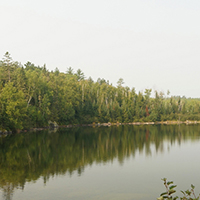
Feds OK Wilderness Mining Lease
View the page for this story
Minnesota is called “the Land of 10,000 Lakes,” and every year hundreds of thousands of people visit the pristine waters of its Boundary Waters Canoe Wilderness Area, and the Obama Administration had blocked a proposed copper and nickel mine next door. Now the mine is back in play after the Trump Administration reversed the ruling. Democratic Rep. Betty McCollum of Minnesota’s 4th congressional district tells host Steve Curwood that the sulfide ore mining process used to extract copper and nickel is known to pollute waters with acid, arsenic, mercury, and lead. (12:00)

Heat Drives Migration
View the page for this story
Rising temperatures in agricultural regions in developing countries correspond with an increase in refugee numbers seeking asylum in Europe, according to research published in the journal Science. Columbia University economist Wolfram Schlenker tells host Steve Curwood that if global warming gas emissions continue at the present pace the number of asylum seekers to Europe could increase by nearly 200 percent. (06:20)
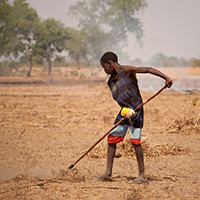
African Dams Dry Up Wetlands & Local Jobs
View the page for this story
Dams in the Sahel of Africa can provide power and flood control, but the absence of seasonal floods is changing wetland environments and wrecking the livelihoods of people who depend on them. Journalist Fred Pearce connects the dots with host Steve Curwood from dams to parched wetlands to fishermen with no work, to desperate people leaving for Europe or joining terrorist groups like Boko Haram. (12:50)
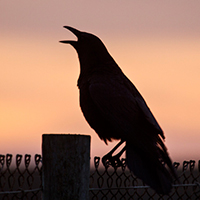
BirdNote®: Dawn ‘Round the World
/ Mary McCannView the page for this story
As the sun rises around the Earth, melodious birdsong wakes the world, as Mary McCann celebrates in today’s BirdNote®. (02:45)
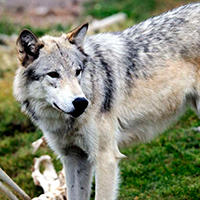
Safer Solutions for Hungry Wolves -- Emerging Science Note
/ Savannah ChristiansenView the page for this story
Many ranchers in the west blame wolves for lost livestock, but a new study of predator control techniques may have found an alternative to killing these predators. Living on Earth’s Savannah Christiansen explains the strategy in this week’s Note on Emerging Science. (02:00)
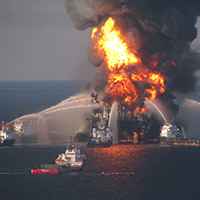
The Headlines & Beyond Previews 2018
/ Peter DykstraView the page for this story
Peter Dykstra joins Steve Curwood to assess the environment and politics as the year turns, and finds little cause to think the current deregulatory push by the Trump Administration will change. Still, the states have become bright spots in the renewable energy sector and Congress is showing a bit more commitment to climate action. (07:15)
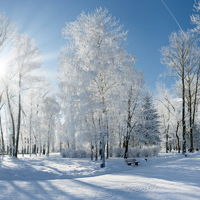
Sounds of Winter
/ Sy MontgomeryView the page for this story
Listen closely. The frigid months of winter have a sound uniquely their own. As commentator Sy Montgomery points out, the cold and gray season’s bareness and rigidity help make its sounds vibrant. (04:00)
Show Credits and Funders
Show Transcript
HOST: Steve Curwood
GUESTS: Betty McCollum, Wolfram Schlenker, Fred Pearce
REPORTERS: Savannah Christiansen, Mary McCann, Peter Dykstra, Sy Montgomery
[THEME]
CURWOOD: From Public Radio International, this is Living on Earth.
[THEME]
CURWOOD: I'm Steve Curwood. The Interior Department blocks an Obama ruling to permit mining next to a prized wilderness.
MCCOLLUM: Boundary Waters Canoe Wilderness Area is 1 million acres of unspoiled woodlands; more than 1,000 pristine lakes beloved by people in Minnesota but adventurers, campers, sportsmen and women from all across the country and people from all over the world come visit this wilderness.
CURWOOD: The planned copper and nickel mines could foul the waters.
MCCOLLUM: Minnesota has a proud tradition of mining. But right now there is no way forward to do this sulfide ore mining without polluting water. And this water would not do anything but flow north into the Boundary Waters, and then eventually into the waters adjacent to Canada.
CURWOOD: That and [BIRD SONG] the sound of dawn around the world and more this week on Living on Earth – Stick Around!
[NEWSBREAK MUSIC: Boards Of Canada “Zoetrope” from “In A Beautiful Place Out In The Country” (Warp Records 2000)]
[THEME]
Feds OK Wilderness Mining Lease
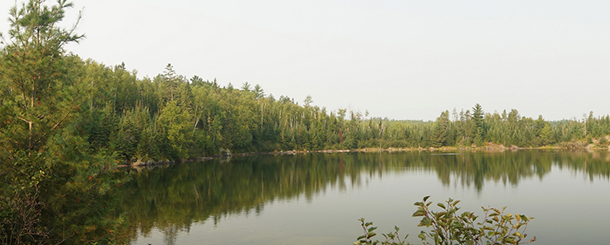
About half of the Boundary Waters Canoe Wilderness Area is covered in water; the rest is dense forest. (Photo: Greg Gjerdingen, Flickr CC BY 2.0)
CURWOOD: From PRI, and the Jennifer and Ted Stanley Studios at the University of Massachusetts, Boston, this is Living on Earth. I’m Steve Curwood. If you’ve ever used Scotch Tape you may have noticed that it’s made by 3M, which is an acronym for the Minnesota Mining and Manufacturing Company that began back in 1902. And in this state called the Land of Ten Thousand Lakes, iron mines became big business, though most of them played out years ago. Now there is a move to mine copper and nickel right next to the popular and massive Boundary Waters Canoe Wilderness Area.
Fifty or so years ago copper mine developers leased land next to this crown jewel of wilderness from the government, but never starting mining. And then a few years ago when these Minnesota copper and nickel deposits caught the attention of Antofagasta, a Chilean mining company, and it tried to renew the expired leases the Obama Administration said no -- not without environmental review. And just two days before Christmas a top lawyer for the Trump Interior Department issued a written ruling nixing the review on the grounds that the previous administration had "improperly interpreted the leases,” thus giving a green light to the project.
Antofagasta mining is owned by billionaire Andrónico Luksic who also happens to own a Washington, D.C. mansion he bought right after the 2016 elections and turned over to Ivanka Trump and Jared Kushner to rent as their home. Joining us now is Betty McCollum, Democratic Representative for Minnesota’s 4th congressional District. Rep. McCollum, welcome to Living on Earth!
MCCOLLUM: It's good to be here with you.
CURWOOD: Please, first tell us about the Boundary Waters Canoe Area Wilderness, and why it's so important to your state, including by the way, city dwellers like your constituents down in St Paul?
MCCOLLUM: Well, the Boundary Waters Canoe Wilderness Area’s not just important to everyone in Minnesota. We're so proud that we have a significant wilderness located in our state adjacent to Canada, but it's also one of our nation's US greatest treasures that we have within our responsibility to protect for future generations.
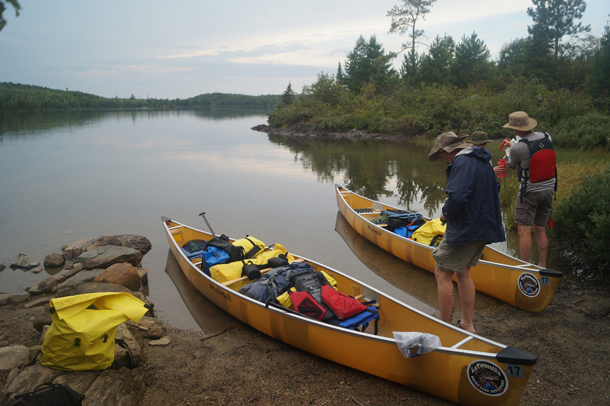
Attracting some 250,000 visitors a year, the Boundary Waters Canoe Wilderness Area contains over 1200 miles of canoe routes. (Photo: Greg Gjerdingen, Flickr CC BY 2.0)
CURWOOD: When was the last time you were there, and how many moose did you see when you were?
MCCOLLUM: [LAUGHS] Well, I didn't see any moose when I was up there, but I am usually up in that neck of the words as we say in Minnesota about once a year. Voyageurs National Park is adjacent to it, so between those two areas I'm up there at least once a year. But the Boundary Waters Canoe Wilderness Area is one million acres of unspoiled woodlands, more than 1,000 pristine lakes that are protected by the US Forest Service, and as you pointed out, they're beloved by people in Minnesota but adventurers, campers, sportsmen and women from all across the country and people from all over the world come visit this wilderness.
CURWOOD: Now, I understand, Congresswoman, that you introduced a bill back in 2015 that would have made federal lands adjacent to the Boundary Waters in the wilderness off limits to mining. Why did you propose to stop heavy metals mining there?
MCCOLLUM: Well, the state of Minnesota, our governor, Governor Mark Dayton, also took state lands and made them unavailable in areas adjacent to the Boundary Waters for mining. And the bill that you refer to in 2015 just prohibited this sulfur ore mining which we know is the most toxic industry for mining in the United States. They pollute waterways with acid drainage that include things like arsenic, mercury and lead. And in 2012 there was a study done of American sulfide ore mines and they found that all of them, every single one of them, leaked. Ninety-two percent of them had experienced failures that negatively affected water quality. So, my bill back in 2015 put a prohibition on that type of mining.
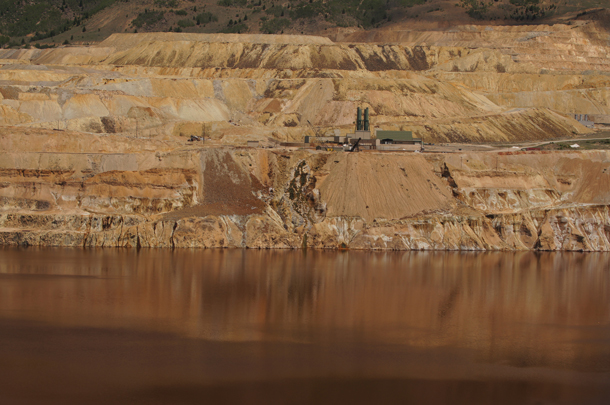
The Berkeley Pit is a former open pit sulfide-ore copper mine located in Butte, Montana that is now filled with heavily acidic water containing arsenic, cadmium, zinc, and sulfuric acid. It’s one of the largest Superfund sites. (Photo: Tjflex2, Flickr CC BY-NC-ND 2.0)
Since then, we've had some changes. The Obama administration wanted to do a two-year study, was taking a time out that there couldn't be any mining leases for 20 years in that area while we really figured out what the potential damage would be from any leakage from these sulfide ore mines, which I mentioned before, they all leak. Since then under the Trump Administration, the Department of Interior, under Secretary Zinke, has renewed these leases which were originally put forward in the 1960s. And so the same royalty payment standards in everything from the ‘60s apply. And if, you know, people who know a little bit about America's bipartisan attempt back in the ‘70s to protect our air and water would know that we need leases that reflect the standards of the Clean Air and Clean Water Act.
CURWOOD: Now, of course, Minnesota is famous for mining. Indeed your big company 3M is, what, Minnesota Mining and Manufacturing. The argument is that these miners can do this right even with the risks, and your response is?
MCCOLLUM: My response is we cannot afford to take a chance on this sulfide ore mining. You know, Minnesota has a proud tradition of taconite mining, and the taconite mining that we do today is through trial and error of learning how to clean up the contamination to our water and to our land with the taconite mining. So, Minnesota has a proud tradition of taconite mining, but right now there is no way forward to do this sulfide ore mining without polluting water.
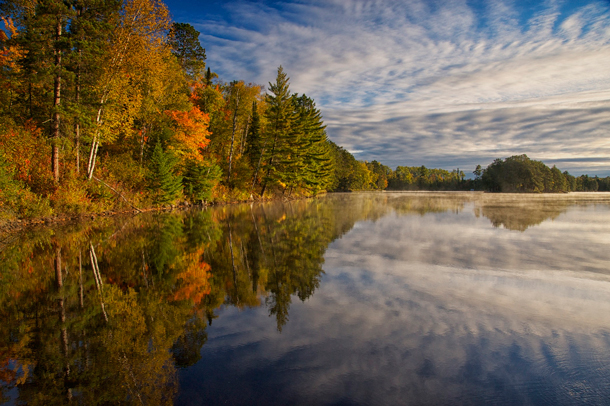
Fall foliage around Farm Lake in the Boundary Waters area. (Photo: Jim Liestman, Flickr CC BY-NC-ND 2.0)
CURWOOD: Talk to me about the type of copper nickel mining operation that is planned to be done there, and where exactly is it in relation to the Boundary Waters Canoe Wilderness Area?
MCCOLLUM: Well, it is adjacent to the Boundary Waters area. So, we're talking about tunneling and mining that are on the shores or tunneling right underneath water that flows back and forth between the Boundary Waters and the non-Boundary Waters. You know, we've all been on the lake, we've all seen maps where there's a dotted line -- go back to your days of geography -- that you know maybe divide a state or in our case, between Canada, the United States and the Boundary Waters. Well, the water doesn't stop. It moves. And so there's no buffer there's no protection that this water, which pollutes, would not do anything but flow north into the Boundary Waters and then eventually into the waters adjacent to Canada. And also through many of our tribal nations’ property as well would be affected with pollution.
CURWOOD: By the way, has Canada raised any objection to this development?
MCCOLLUM: Well, it's been a while since I've had an opportunity to speak to the Canadian government about it. It's on my list to do because this all happened just recently. I've spoken to people from Canada who work in the environmental industry and people who are in the government and they are very concerned because they had a mine similar to the one that's proposed, and there was a huge leak and destroyed acres and acres and acres of timber and wildlife. So, their firsthand experience with this type of mining was, it didn't go very well.
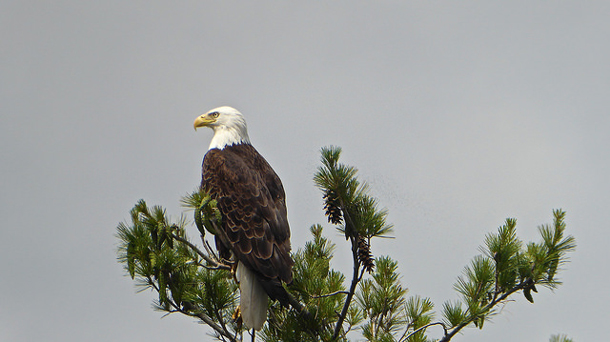
A Bald Eagle perches in nearby Voyageurs National Park (Photo: Fighting Irish 1977, Flickr CC BY 2.0)
CURWOOD: Now, how is the Interior Department under Mr. Zinke justifying the renewal of these mining leases?
MCCOLLUM: Beats me. I mean Secretary Zinke appeared in front of me twice, and I spoke to him as recently as just before the Christmas break, thanking him for moving forward on conducting the study. And every time we've had this discussion in public or in my office, he said, “You know, we need to understand the science on this because the pollution to this water is significant and could be toxic and harmful for hundreds of years”. And then, you know, surprise! Buried in one of the federal documents that come out is a renewal of these leases, and the leases -- if the study had gone forward and we had taken the time out to really understand what was going on, I'm sure these leases, if they would have been moving forward would have been much more stricter standards than the standards in the 1960s. Because after all this is 2018 now!
CURWOOD: What would you like Secretary Zinke to do right now about this?
MCCOLLUM: Well, I would like him to say, “You know, I don't know how this happened, we were talking on the phone. I thought we were going to complete the study”. I'd like him to reverse himself and go back to the study, but somehow or another I don't see that happening in 2018. So, I think this is going to land up unfortunately being in the courts, where it's going to cost US taxpayers a lot more money than to let a thorough research study move forward about the effects of sulfide ore mining. This is going to be a huge loser for the taxpayers as well as for our environment.
CURWOOD: Tell me, what's the reputation as far as you understand it, of Antofagasta, that's the Chilean firm that would develop this copper and nickel mine?
MCCOLLUM: They were just fined recently by their own government for polluting. And as I said, every single one of these sulfide ore mines leak, and so they cannot come in and with any great deal of confidence tell anybody that if they open up this mine -- even as they're do some of the exploratory work that they do -- that there's not going to be any of this pollution, arsenic, mercury and lead into our waters.
CURWOOD: As I understand it, this Chilean firm is owned by the chap who is renting a home in Washington to Jared Kushner and Ivanka Trump. What, if any, relationship do you think there is between the reversal of this lease moratorium and the relationship between the owner and these members of the Trump family?
MCCOLLUM: You know, I'm not aware of anything, but as my grandmother's often told me, “Appearances count for a lot”, and it is a, it's a really bad appearance that there's people in the White House -- the President's daughter and son-in-law -- renting from this company. I would say that this administration has been fraught with conflicts of interest and I would think that they would want to avoid that. So, I know what you know, but as my grandmother says, “it doesn't look good”.
CURWOOD: You know, Representative, I haven't been to the Boundary Waters to canoe. I do that out east. But a lot of people go there. A lot of people like it. I think it's like a quarter million people a year or something, and it's actually a place that if you're in a wheelchair there's accessibility. You can get loaded into a canoe and enjoy the outdoors.
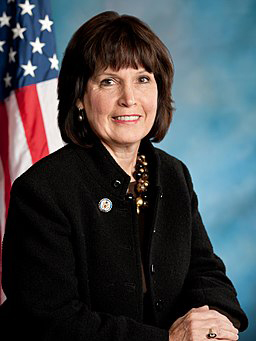
US Rep. Betty McCollum serves Minnesota’s 4th District, in St. Paul. (Photo: US House Office of Photography, public domain)
MCCOLLUM: There are a couple of motorized portages available. We've tried to make all of our parks, all of our national lands accessible to the public. But I also want to just, you know, point out -- there's another wilderness area in the United States is under attack from this administration, that's ANWR, that's the Arctic National Wildlife [Refuge]. In the tax bill, they've opened that up to drilling. In our national parks, there's talk about opening up uranium mining adjacent to national forest lands in the Grand Canyon's watershed. So, it really appears that our public lands are up for sale. And our responsibility -- that I take very seriously as a ranking member on the subcommittee of Interior Appropriations -- is to make sure that we leave some areas for future generations, whether it's our national parks with accessibility, or these very special places like ANWR or the Boundary Waters Canoe Area. We have a responsibility to leave that for future generations, just as generations left that for us, and that is a very sacred trust that usually members of Congress fight very hard to protect. We have a history of trying to make sure that our public lands remain free and open to all of the public to enjoy and that they're just not up for sale.
CURWOOD: Representative Betty McCollum serves Minnesota's fourth US Congressional district from St Paul, Minnesota. Thank you so much for taking the time.
MCCOLLUM: All the best to you, and Happy New Year.
CURWOOD: We asked the Interior Department for further explanation of its decision, but we received no response by our deadline.
Related links:
- Washington Post: “Trump administration renews mining leases near Minnesota wilderness, reversing Obama”
- About the Boundary Waters Canoe Wilderness Area
- Rep. McCollum’s statement on decision to reinstate the mining leases
- The Department of Interior document explaining why the leases can be renewed
- Twin Metals Minnesota Project
- The Campaign to Save the Boundary Waters
[MUSIC: Mark O’Connor and the Metamorphosen Chamber Orchestra/Scott Yoo, Strings & Threads Suite, 12-“Swing” on The American Seasons, composed by Mark O’Connor/arr.Edgar Meyer, Sony Classical]
CURWOOD: Coming up, how European dam builders in Africa helped promote the migration crisis. Keep listening.
ANNOUNCER: Support for Living on Earth comes from the Gordon and Betty Moore Foundation, and from a friend of Sailors for the Sea, working with boaters to restore ocean health.
[CUTAWAY MUSIC: Mark O’Connor and the Metamorphosen Chamber Orchestra/Scott Yoo, Strings & Threads Suite, 11-“Texas Dance Hall Blues” on The American Seasons, composed by Mark O’Connor/arr. Edgar Meyer, Sony Classical]
Heat Drives Migration

More than a million refugees and migrants are seeking safety in Europe. (Photo: United Nations)
CURWOOD: It’s Living on Earth, I’m Steve Curwood. Unrest, war and terrorism have helped boost the numbers of desperate people fleeing parts of the Middle East and Africa. And now research shows a warming planet may also be a culprit. A study in the journal Science links higher temperatures in agricultural regions with the flood of people seeking asylum in the EU. What’s more, if current temperature trends continue, the EU can expect an additional 600,000 or more refugees begging to come in each year, nearly twice as many as those who currently seek asylum. Wolfram Schlenker, a co-author of this paper, teaches Economics at Columbia University and he joins me now. Welcome!
SCHLENKER: Thank you for having me.
CURWOOD: So, first of all tell me about your study. What countries did you include in your research, and what exactly were you looking for?
SCHLENKER: So, we looked at destination countries within the European Union. The main motivation for looking at the European Union was that it absorbs about 45 percent of all asylum applications. And then we basically just looked systematically all around the world. We ended up with 103 source countries for which we had data on temperatures. So, we used satellite scans about where the agricultural area is, where crops are grown. They are responsible for 93 percent of all asylum applications that the European Union gets.
CURWOOD: So, what is your basic finding then?
SCHLENKER: So, the paper is two parts. The first part is just linking for 15 years 2000 to 2014, year-to-year changes in weather. Was it hotter than average or colder than average, and as a result, do asylum implications to the European Union from that country increase or decrease? What we find is this non-linear relationship. Around 20 degrees Celsius, which is 68 degrees Fahrenheit, we see that asylum applications seem to be lowest. And if you're hotter or colder, they tend to increase. So, what this implies is if that you're a country which currently has a temperature that is higher than this optimal 20 degree Celsius level, you would see an increase with warming. If you are in a country that currently has a temperature that is lower than the 20 degrees Celsius optimum you would actually see a decrease from warming.
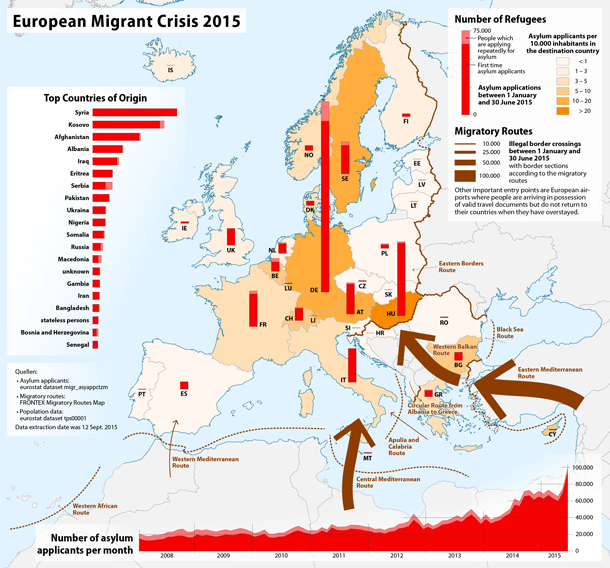
2015 saw a spike in refugees seeking asylum in Europe. (Photo: Maximilian Dörrbecker (Chumwa), Wikimedia Commons CC BY-SA 2.0)
CURWOOD: That's the first part of your paper. What's the second part?
SCHLENKER: The second part of the paper then basically uses this statistical relationship that I'm fairly confident in, and extrapolated out to the end of the century until 2100, and tries to predict what would happen though asylum applications in the future. And there we find that under a business as usual scenario -- continued use of fossil fuels, high population growth -- asylum implications to the EU are predicted to increase by 188 percent, while under a medium scenario you would basically only see a 28 percent increase.
CURWOOD: It's interesting, but people just can't seek asylum because it's getting too warm to farm the way they used to. Refugees have to prove that they're subject to persecution at home ordinarily.
SCHLENKER: It's definitely accurate that people who seek asylum protection need to basically prove that they were persecuted in their home country. Now, there's a lot of literature to basically show that weather shocks lead to conflict, lead to civil unrest. So, we think the likely mechanism behind here is that the weather is bad for agriculture and you don't do as well, you actually see an increase in conflict because it sort of pays more to join a conflict than to farm your farm.
CURWOOD: What's the data that you see about the availability of food and hunger as a result of increased temperatures and declining agricultural productivity?
SCHLENKER: In earlier studies, co-authors of mine and I have shown that especially extreme heat is very detrimental to agricultural output, so this relationship seems to be fairly consistent all over the world and then temperatures go above. There, it's on a daily basis, not on a seasonal average, but on a daily basis about 30 degrees Celsius we see very sharp drops and yields for that at the end of the season.
CURWOOD: Now, when you're doing scientific research there's a big difference that you guys notice between correlation and causation. How confident are you that increased temperatures are actually causing an increase in the number of refugees?
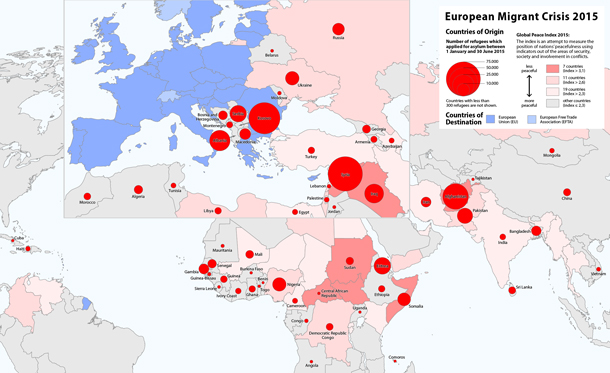
Source countries for immigration to Europe. (Photo: Maximilian Dörrbecker (Chumwa), Wikimedia Commons CC BY-SA 2.5)
SCHLENKER: I think there are two steps to this answer. So, in the first part of the paper where we look at the relationship between those weather shocks and asylum applications, I'm very confident we uncovered a causal relationship because those weather shocks -- again those deviations, whether you're hotter than normal or colder than normal -- are random and exogenous. So, that's not just a correlation. I'm pretty sure this is a causal relationship. Now, the second step is basically using that observed statistical relationship in fast-forwarding it 80 years into the future, and there we need this big assumption that we hold everything else constant, and you might argue that in 80 years things might change.
Now, it's not clear our priority in which direction things might change. On the one hand, people might adapt, become better at withstanding higher temperatures, therefore, you might expect that in the future you see a less sensitivity to a temperature than you observe now. On the other hand, you might argue that right now we're basically measuring the effect of getting once in a while of bad outcome, like a hot year, that diminishes your agricultural yields or leads to more aggression. While in the future with climate change you would observe those years in a row several times, and you might think that this might lead to further unraveling, that you might be able to basically to stand a shock once if it happens once in a while but couldn't withstand it every single year. So, the estimate actually also be a lower estimate if then in the future this further unraveling that we're not capturing right now.
CURWOOD: Wolfram, how well do you sleep at night knowing this research that you know now?
SCHLENKER: So, I think there is a myriad of impacts of climate change in various countries. I also think, though, I really believe in the human ingenuity. I really believe that humans have ways to combat climate change. And so far, I feel like the best estimate is that it's not that costly, considering to what the potential benefits might be. So, I personally feel that with human action, with human engineering and new developments, we might very well still be feasible in achieving something, but what we need is the political willingness to engage in that.
CURWOOD: Wolfram Schlenker is a professor at Columbia University. Thank you so much for taking the time with us today.
SCHLENKER: Thank you for having me.
Related links:
- The paper in the journal Science: “Asylum applications respond to temperature fluctuations”
- Wolfram Schlenker is a professor at Columbia University
African Dams Dry Up Wetlands & Local Jobs
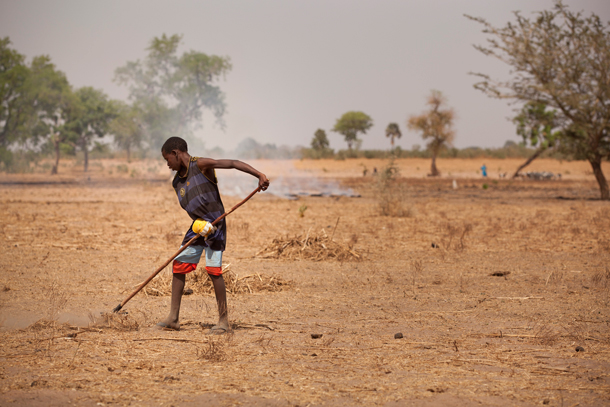
As dams divert water from downstream and stop seasonal floods, farmland dries up in the Sahel region of Africa. (Photo: IFPRI/Milo Mitchell, Flickr CC BY-NC-ND 2.0)
CURWOOD: Large dams often draw scrutiny for their impacts on the local habitat, from fish stocks to plant life. But they can also disrupt society, rendering traditional livelihoods obsolete in the name of economic development. Writing for the online publication Yale Environment 360, journalist Fred Pearce describes how the loss of wetlands is helping fuel Africa’s migrant crisis. He joins me now from London. Welcome back to Living on Earth.
PEARCE: Thank you. Good to be there.
CURWOOD: Fred, first describe to me what’s happened to the wetlands in the Valley of the River Senegal where you've done a lot of reporting.
PEARCE: Essentially, they're drying up. Back in the 1970s, 1980s, at least I'm old enough to remember that we had a series of massive droughts in Africa, famines and so on in Ethiopia right across West Africa. And in that time governments decided they wanted to set up irrigation projects, and they also started to dam the main rivers in the region for hydroelectricity. They wanted to make more economic use of these rivers, and they hoped to maintain them in dry times. But there have been a series of perverse consequences of damming of the rivers. The worst of them has been the loss of the wetlands that the rivers in full flood used to fill every year. The water is now held back behind dams, the flooding simply doesn't happen anymore. And what has been forgotten I think is that millions and millions of people are dependent on these wetlands. There are some two million people in the inner Niger delta. There are probably 10 million people in and around Lake Chad and along the flood plains of the rivers that used to fill Lake Chad. And with water being held back, the result for these people has not been more prosperity, but a loss of the basic natural resources on which they rely. So there are no fish in their lakes. The old system of irrigation which relied on planting crops in the wet soil as the annual floods retreated -- there are no wet soils now to plant crops in.
Similarly, pastoralists used to, and still do to some extent, bring their cattle from all across the region to these wetlands. They are the last green parts of the Sahel during the dry season of the year. If these areas are no longer wet, the cattle have nowhere to go. So, whole series of livelihoods based around fish and climbing and nomadic cattle herding have been seriously damaged. People simply don't have livelihoods anymore.
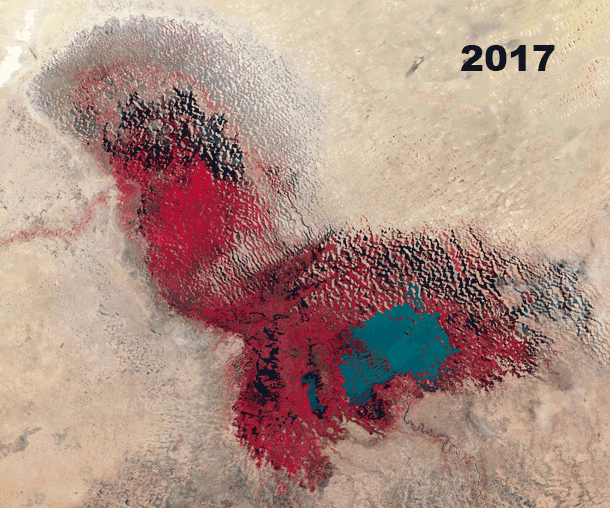
Lake Chad from 1973 to 2017 (Photo: NASA Earth Observatory)
CURWOOD: No way to make a subsistence living; what's happened to people?
PEARCE: Well, they're simply moving out. To start with, people are moving to the capital cities of their countries, to Bamako in Mali, to Dakar in Senegal, and other major urban centers to look for work. Now, people have always done that but they used to move backwards and forwards. You do that in a bad drought season and then go back to your fields and your pastures when the rains return. But these days with no water coming down, people are leaving for the cities for good, but increasingly making international migrations. Increasingly, people have been taking people smuggling routes across the Sahara desert into Libya and then taking very dangerous boats to try and land in the European Union, in Italy or sometimes in Greece. So, people are taking desperate steps to try and find a better life.
CURWOOD: What has this done for political stability in the region?
PEARCE: Around Lake Chad it's extremely bad. You probably have heard the stories of the Islamic terror group Boko Haram in that region, which famously kidnapped more than 100 schoolgirls a couple of years ago, and there have been a huge number of other atrocities. Essentially the region around Lake Chad is now a no-go area, particularly in Nigeria. And the reason for this is really a social breakdown, because people without resources have been moving around, looking for somewhere else to go. People who once fished in Lake Chad -- well, their fishing villages are now tens of kilometers from where the water is -- so they're moving on looking for somewhere else to go, landing up in refugee camps.
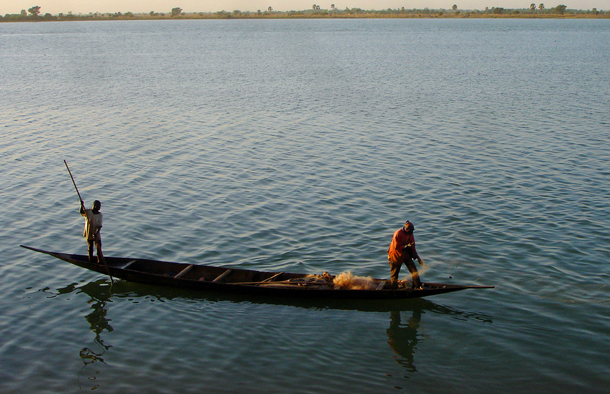
Fishing in the Sahel region has become much more difficult as dams have restricted flow to rivers. (Photo: Carsten ten Brink, Flickr CC BY-NC-ND 2.0)
And of course, militant groups take advantage of this, take advantage of the dislocation of young people and the sort of breakdown of the law and order that follows from this, and we're having a wider breakdown of law and order in which millions of people are homeless and many of those homeless people are just shipping out all together. So, I wouldn't say the social breakdown is all because of environmental issues. There are a lot of other social factors involved. But the breakdown of the environment is undoubtedly contributing to a breakdown of the law and order, and the rise of Islamic groups, and partly as a result movement of people out of the area. They just don't want to live there anymore.
CURWOOD: Fred, in the course of your research I know you talked to a number of people. Tell me an anecdote of a migrant who was caught up in this.
PEARCE: Well, let me give you, give me two anecdotes. I met people on the shores of Senegal in West Africa, people who used to be fishers on the river Senegal who found that there were no more fish in the river. So, they moved to becoming ocean fishers, and they used to take their boats out into the coastal waters along Senegal, a rich fishing area. And then they found that European trawler boats had moved into this area. The national government had sold fishing rights to European trawlers, and there were many fewer fish. So, I met one, one day who'd just been picked up by the local police because he'd been trying to get on a boat and take his boat to the Canary Islands way out in the Atlantic territory owned by Spain because he wanted to move to Europe. So, he had made a clear progression. The rivers weren't delivering fish, so he went to the ocean. The ocean wasn't delivering fish, so he was going to get out, and he was going to go to Europe.
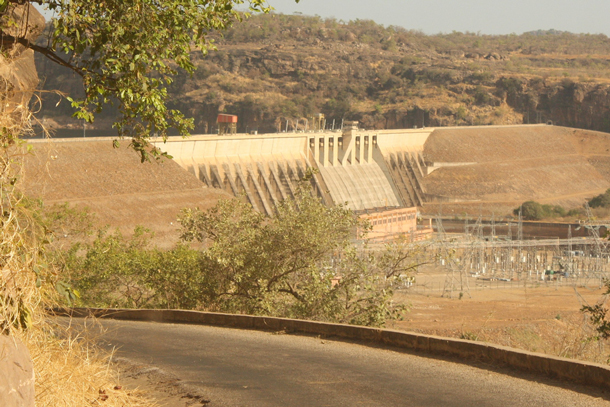
Manantali Dam in the Senegal River basin (Photo: Benoît Rivard, Flickr CC BY-NC-ND 2.0)
And along the Senegal River Valley, I've met many people in small villages where they told me that most of the community of those villages had left. There were a few people around, but not many. I met schoolteachers and farmers and pastoralists, middle aged men who told me, “You know some of my friends in the last few years have left and they're now phoning me back from Europe and saying they’ve got money now, they’ve got jobs, they're making a go of their lives, some of them have become university graduates, and I'm stuck at home still trying to fish in the river, still trying to look after my cattle, and I'm dirt poor. So, next year I'm going too”. These are the stories about real people trying to live their own lives. They are not victims in the sense that they have no resources, no possibilities. They're not heading for refugee camps. These are regular people in small rural communities who are thinking about their lives and the lives of their families and their children, and they're thinking, “What are we going to do, how are we going to react to the new situation in which we find ourselves?” More and more of them are saying, “I'm going to take my life into my own hands. I'm going to either migrate myself or tell my children to get out of here”.
CURWOOD: Fred, how much of the drying up of the wetlands is the result of climate change versus humans interfering with river flows?
PEARCE: It has very little to do with climate change at this point. We had some dry years in the 1970s and 1980s, but since then rainfall has largely recovered. You can't blame the low flows in the rivers or the lack of water getting into critical wetlands -- you can't blame that on climate change. This is a result of decisions taken about damming rivers to hold back water for other purposes, decisions often taken in response to the droughts of past years. But as it has turned out, they have made things worse in many rural communities.
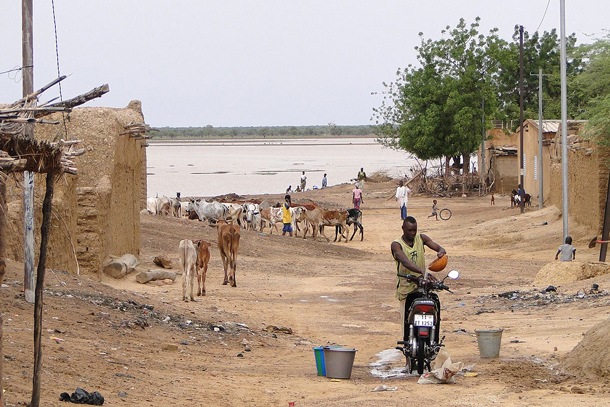
A street scene in Burkina Faso, in the Sahel region of Africa. (Photo: Adam Jones, Wikimedia Commons CC BY-SA 3.0)
CURWOOD: So, to what extent are development agencies looking at this issue, looking at the value of the wetlands vis-à-vis the possible gain from putting these dams in?
PEARCE: They've taken the same view of the national governments in Africa that they want economic development in a kind of western form of delivering money for national exchequers, measurable international trade in goods. The trouble is, much of the wealth that comes from wetland is never kind of monetized. It happens way out in the bush. Lots of people with subsistence livelihoods or trading in rather traditional manners in fish across the region -- I've seen that. And that kind of never shows up in national statistics and I think governments ignore this and I think aid agencies have been guilty of ignoring this. Not all. Some groups, the Red Cross talks about these issues, Oxfam and some others talk about these issues, but it has kind of been forgotten because this kind of economy, this basic economy for rural people doesn't show up very often in national statistics, and I think increasingly in development community it's now realized that some really bad decisions were taken. And I think environmentalists have been guilty too. Environmentalists have traditionally seen wetlands as places where it's great for bird life, fisheries and so on. So, they look at it from a wildlife perspective. But the point that millions of humans also depend on these wetland environments has kind of fallen through the gaps. The development agencies didn't think about it, governments didn't think about it, and even environmentalists who probably knew more about these wetlands than most outsiders, even they were ignoring the human consequences of their drying up.
CURWOOD: Now, Fred. Talk about some of the possible fixes here. What about a massive release of water now and then to mimic a flood? This technique has been used, for example, here in the United States on the Colorado River.
PEARCE: Yes, indeed you can do it, and for a short term, it will work. But in practical terms it's not often been very successful. You have to think about who built hydroelectric dams. What was the purpose of these dams? If they were built to provide hydroelectricity, then the people in charge of the turbines, the people in charge of the sluice gates, are the people generating the electricity. So, while you might have a release one year, the practical experience is that after a couple of years that doesn't happen. So, in Cameroon some of the rivers that flow down into Lake Chad, people 15 years ago were making a big point that people on the river floodplain were losing out and the government got a bit interested in this. For a couple of years they put in an artificial flood, if you like, and they released water during the natural flood season, and that was beneficial. And then it was a pilot project and the pilot project ended and nobody carried on, even though the benefits for the downstream communities were clear.
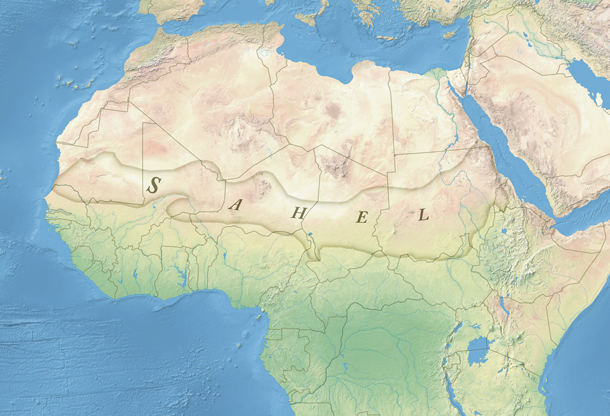
The Sahel region of Africa (Photo: Munion, Wikimedia Commons CC BY-SA 3.0)
CURWOOD: Fred, what you described sounds like an epic disaster in slow motion. Who's pushing back against this? Who is advocating for those people who have subsistence livings based on these wetlands?
PEARCE: In every country I went to, I found government officials, but also NGOs and other people within the countries arguing very strongly for the kind of things that I say, pointing out the value of wetlands and the importance of providing water down rivers to maintain wetlands, for instance. So, it's not as if nobody knows, it's not as if nobody cares. The problem is these messages kind of get lost as they go up the decision chain, so that it is harder to get those ideas across to the people who run the hydroelectric dams, to the people who are the government ministers. There are international agreements which talk in general terms about the sustainability of wetlands and protecting livelihoods and that kind of thing, but when you get from those abstract words into the real nitty-gritty of what you do on a river, the message again seems to get lost and you know, there are urban priorities that are rather different from rural priorities. And urban priorities, not just in Africa but in most of the world, have greater force and are heard more loudly. Trouble is, of course, in much of West Africa or in Central Africa most people are still in the countryside whereas most of the decision makers are in towns.
CURWOOD: Fred Pearce is an author and journalist based in London, and a contributor to Yale E360. Fred, thanks so much for taking the time with us today.
PEARCE: Pleasure, thanks very much. I enjoyed it.
Related links:
- Yale E360: “How Big Water Projects Helped Trigger Africa’s Migrant Crisis”
- The New Yorker: “Lake Chad: The World’s Most Complex Humanitarian Disaster”
BirdNote®: Dawn ‘Round the World
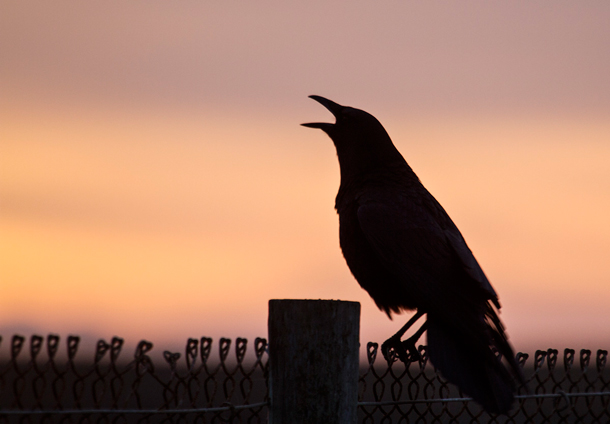
An American Crow welcoming the dawn (Photo: Marlin Harms)
[MUSIC: BIRDNOTE® THEME]
CURWOOD: With a New Year comes a fresh chance to enjoy some wonders of our world. Here’s Mary McCann with today’s BirdNote.
http://www.birdnote.org/show/new-year-dawns
BirdNote®
A New Year Dawns
Recorded by Gordon Hempton
Written by Chris Peterson
This is BirdNote!
Listen! The earth awakens as dawn circles the globe.
[Nature recordings from around the globe]
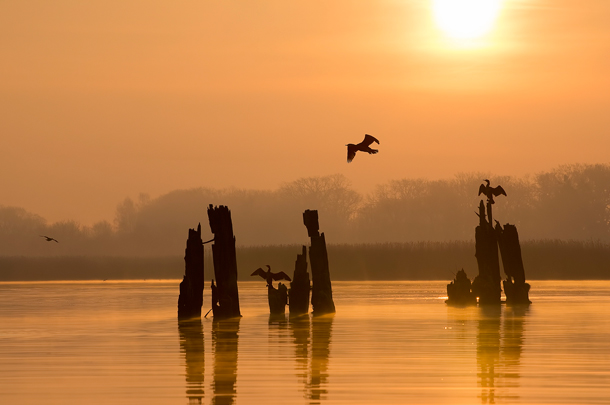
Cormorants in the soft light of a new day (Photo: Artur Rydzewski)
Sounds for today’s BirdNote were recorded, around the globe, by Gordon Hempton, Soundtracker.com. I’m Mary McCann.
###
Dawn sounds recorded and provided by Gordon Hempton, Soundtracker.com. Used with permission. For more, visit www.soundtracker.com
Producer: John Kessler
Executive Producer: Chris Peterson
© 2005-2018 Tune In to Nature.org / BirdNote January 2018 Narrator: Mary McCann
http://www.birdnote.org/show/new-year-dawns
CURWOOD: And for pictures, wing on over to our website, LOE.org.
Related links:
- The “New Year Dawns” story on the BirdNote® website
- Acoustic ecologist Gordon Hempton, a.k.a. “The Sound Tracker”, recorded these sounds
CURWOOD: Coming up, diving beyond the headlines for an environmental preview of 2018. That’s just ahead here on Living on Earth. Stay tuned.
ANNOUNCER: Funding for Living on Earth comes from you our listeners, and United Technologies -- combining passion for science with engineering to create solutions designed for sustainability in aerospace, building industries and food refrigeration. UTC companies such as Otis, Carrier, Pratt & Whitney and UTC Aerospace Systems are helping to move the world forward. You can learn more about United Technologies by tuning in to the Race to 9 Billion podcast, hosted by UTC’s Chief Sustainability Officer. Listen at raceto9billion.com. That’s raceto9billion.com. This is PRI, Public Radio International.
[CUTAWAY MUSIC: Chris Barber & Dr. John (et al), “Perdido Street Blues” on Take Me Back To New Orleans, composed by Chris Barber, Black Lion Records]
Safer Solutions for Hungry Wolves -- Emerging Science Note
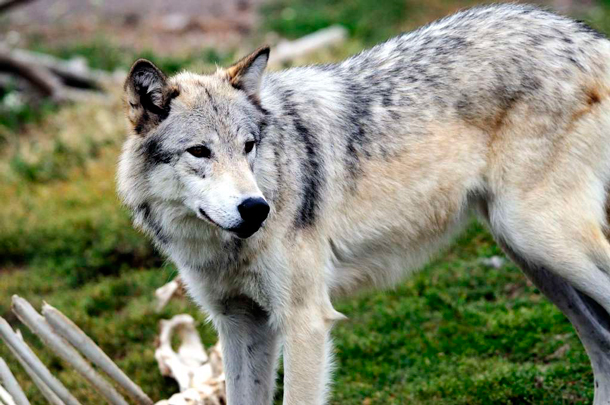
Wolves now roam many parts of the American West, and run-ins with ranchers occur frequently. Sometimes ranchers and wildlife managers resort to shooting problem wolves – but a study suggests non-lethal predator control methods can be more effective. (Photo: Jason Bechtel, Flickr CC BY-NC-ND 2.0)
CURWOOD: It’s Living on Earth, I’m Steve Curwood. In a moment, tuning in to the special sounds of winter, but first this note on emerging science from Savannah Christiansen.
[SCIENCE NOTE THEME]
CHRISTIANSEN: When wolves were reintroduced into the West in 1995, their presence led to more vibrant ecosystems, but also sparked controversy over predator control methods. Ranchers were wary about wolves preying on their livestock, while conservationists wanted to restore their once vital role in the landscape. That tension between ranchers and conservationists is still alive in central Idaho, where in 2007 a wolf pack starting preying on livestock in the state’s largest grazing area. The pack was killed but new wolves simply moved in and took more sheep.
To find a solution to the conflict, Suzanne Stone at the advocacy group Defenders of Wildlife developed alternative predator control techniques with ranchers in the area, and partnered with Stewart Breck of the USDA’s Wildlife Services Program, which typically kills predators. Their 7-year study compared lethal and nonlethal predator control methods in the overlapping livestock and wolf ranges in Idaho’s Sawtooth National Forest. The team recorded data from two areas: a protected one where ranchers used nonlethal techniques such as noisemakers, guard dogs and tying strips of colored cloth to a rope around grazing areas, to deter wolves. The other area was adjacent but unprotected, where wolves could be killed.
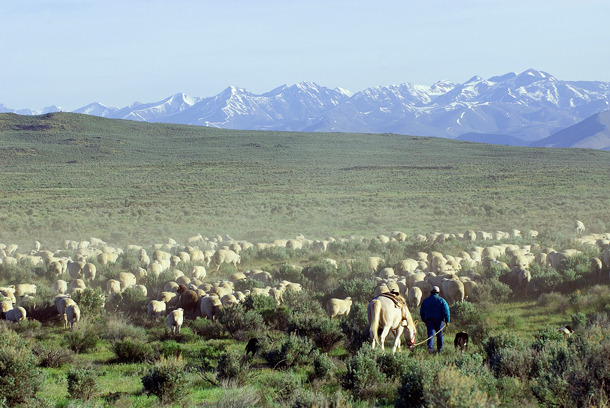
When ranchers in Idaho’s Blaine County shot dead a wolf pack in 2007 in hopes of stopping the predation of their sheep, another pack moved in shortly thereafter. (Photo: Bureau of Land Management, Flickr CC BY 2.0)
The researchers found that in the unprotected area, three and a half times more sheep were lost to wolves than in the protected area where the predators were left alive. And nonlethal methods proved a lot cheaper for livestock managers, just about a dollar a head per sheep, much less costly than the rifles and traps needed to kill entire wolf packs. On top of that, nonlethal techniques also helped ward off other predators, such as mountain lions, coyotes and grizzly bears.
The researchers emphasize that their study, published in the Journal of Mammalogy, is the first of its kind on such a large scale. They hope the results will provide ranchers with tools to develop their own tailored, nonlethal strategies to preserve both livestock and wildlife. That’s this week’s note on emerging science, I’m Savannah Christiansen.
[SCIENCE NOTE THEME]
Related links:
- Journal of Mammalogy: “Adaptive use of nonlethal strategies for minimizing wolf-sheep conflict in Idaho”
- Yellowstone National Park: “Wolf Reintroduction Changes Ecosystem”
- The Wood River Wolf Project
- Suzanne Stone, Senior Representative Northwest Program at Defenders of Wildlife
The Headlines & Beyond Previews 2018
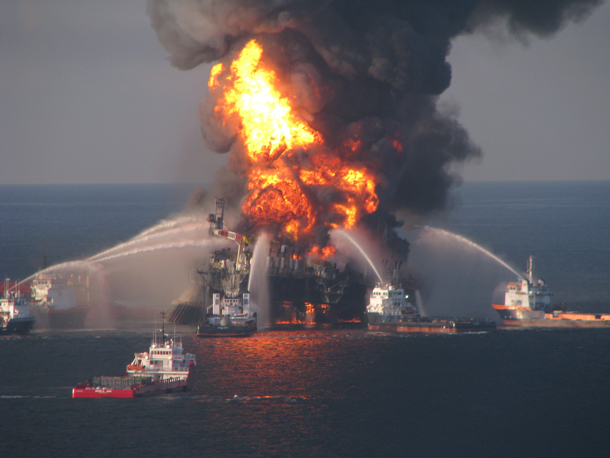
Following the Deepwater Horizon oil spill, Republican Congressman Joe Barton argued the White House needed to apologize for its harsh treatment of BP. He has stated he will not be seeking reelection in 2018. (Photo: EPI2oh, Flickr CC BY-ND 2.0)
CURWOOD: Now, to help put last year into perspective and get prepared for this one, there’s no one better than Peter Dykstra. Peter’s an editor with DailyClimate dot org and Environmental Health News, that’s EHN dot org. He’s on the line from Atlanta, Georgia now -- Happy New Year, Peter!
DYKSTRA: And happy New Year to you, Steve, although what I’m about to say isn’t all that happy.
There’s absolutely no reason that the Trump Administration’s anti-regulatory juggernaut won’t continue in 2018, and absolutely no reason that efforts to protect the environment and battle climate change won’t suffer because of it.
CURWOOD: Gee, you’re full of your usual good news, I note, Peter.
DYKSTRA: Yeah, I never want to disappoint. So let’s look at some of what we expect this year, based on what we saw in 2017, but let’s also take stock of a few encouraging environmental items.
The U.S. ended the year as the only holdout on the Paris Climate Accord after President Trump withdrew the U.S. from it. Two other non-signers, Nicaragua and Syria, have signed up, leaving the U.S. in a position to assertively forfeit any claim it might have had to climate leadership.
And as if to underscore the role of climate denial in the White House, Mr. Trump took to Twitter in the final days of 2017 to assert that cold and snowy weather in the Northeast US was further confirmation of a climate hoax.
CURWOOD: Proving yet again that he doesn’t grasp how weather is not the same as climate. But hey, Peter, overall, would you agree that climate denial is in decline?
DYKSTRA: Yeah but if it is, it’s still pretty healthy in US politics: in congressional leadership, Cabinet secretaries, and in old-line party leaders like Mitch McConnell, Newt Gingrich, and one who’s suddenly poised for a comeback, Mitt Romney.
15 years ago as Massachusetts Governor, Romney pulled together an ambitious Climate Action Plan. When he ran for President in 2012, he conspicuously left his climate portfolio behind. Now that he’s the frontrunner to succeed retiring Utah Senator Orrin Hatch, I’d be stunned if he gets religion on climate again.
CURWOOD: But wait, there’s the Congressional Climate Solutions Caucus? They’re bringing in some Republicans, right?
DYKSTRA: Yeah, over thirty Republicans, in fact. That’s a significant shift, but it’s a long way from a climate consensus. Let’s see if this group can have any impact in an Election year.
What was obviously the biggest impact of environmental politics in 2017 was both obscure and pretty clearly cynical.
When Senate leaders were furiously tying up loose votes to pass the tax bill, Alaska’s Lisa Murkowski came on board in exchange for drilling in the Arctic National Wildlife Refuge – a bone of contention for nearly four decades.
CURWOOD: Yeah and one that won’t generate much tax revenue until and unless oil prices rise much more than they have, since the current prices won’t make Arctic oil worth the expense.
DYKSTRA: Yeah and Big Oil’s man in the Cabinet, former ExxonMobil CEO Rex Tillerson, paradoxically finds himself as pretty much the closest thing to Green in the Administration.
CURWOOD: For now.
DYKSTRA: Yeah, for now, with widespread reports that he’s a short-timer as Secretary of State. And two other guys with Big Oil ties say they’re definitely leaving at the year’s end.
CURWOOD: Oh really? From the Administration, or Congress?
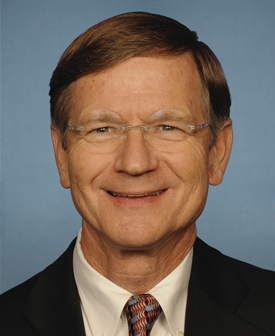
Republican Congressman Lamar Smith will also be retiring from the House of Representatives in 2018. Smith has been among the most vocal climate deniers in Congress and has served as Chair of the House Science Committee for six years. (Photo: US House of Representatives, Wikimedia Commons CC)
DYKSTRA: Well these are two Texas Congressmen who have been conspicuously friendly toward Big Oil and they have said they won’t run again in 2018. One is Lamar Smith, who has been among the most effective climate deniers in his six-year run as Chair of the House Science Committee.
Smith has launched inquiries into both scientists and political figures who have advocated action on climate. His district in the Texas Hill Country will almost certainly remain in Republican hands, and the Science Committee may end up in the hands of another climate denier, California’s Dana Rohrabacher.
CURWOOD: Yes, his climate credentials are about the same as Lamar Smith’s, I’d say.
DYKSTRA: Right, and Congressman Rohrabacher is a surfing enthusiast who doesn’t want the EPA regulating things like Clean Water, so go figure.
CURWOOD: And who’s the other departing Texan?
DYKSTRA: It’s Joe Barton, less-than-affectionately known as Smoky Joe Barton for his steadfast opposition to climate action and clean air measures. He’s represented a district between Dallas and Fort Worth since 1985.
CURWOOD: So Peter, wasn’t he the representative who came to BP’s defense after the Deepwater Horizon oil spill?
DYKSTRA: He was. Smoky Joe actually demanded that the White House apologize to BP for being a little too rough on them after the spill. He also regards climate science as “Junk Science” but in 2017, it was Barton’s turn to apologize when pictures of his own junk showed up in social media.
CURWOOD: Kind of difficult to survive that in the current climate, one could say.
DYKSTRA: Yeah. But speaking of Deepwater Horizon, some Obama-Era regulations on offshore oil safeguards are being rolled back – not just on preventing spills, but on preventing the kind of blowout that killed eleven workers aboard that rig.
There’s no reason the rollbacks won’t continue in the new year – in late December, the Trump Administration rolled back restrictions on well drilling and wastewater release from fracking projects on public lands; and if we’re making it easier to frack, let’s send EPA Administrator Scott Pruitt overseas with a marketing pitch for American natural gas.
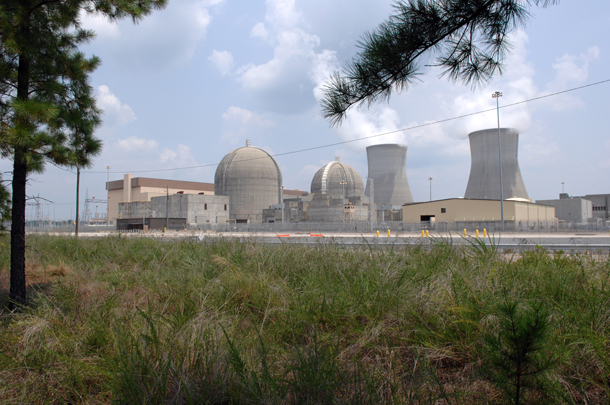
Plant Vogtle, in Waynesboro, GA, is adding two nuclear reactors to its existing facilities. Energy Secretary Rick Perry recently signed off on $3.7 billion in loan guarantees for the development. (Photo: Nuclear Regulatory Commission, Flickr CC BY-NC-ND 2.0)
CURWOOD: But wait a minute – our chief environmental protector traveled to hawk a product he’s supposed to be regulating?
DYKSTRA: Yeah, Scott Pruitt went to Morocco in December to sell fossil fuel exports – not a part of the job description of any previous EPA administrator from either party. The trip cost a reported $40,000, and that’s not including Mr. Pruitt’s drastically expanded security detail or his installation of a Get Smart-like Cone of Silence in his office.
And speaking of cash, Energy Secretary Rick Perry signed off on another 3.7 billion dollars in loan guarantees for Plant Vogtle here in Georgia. They’re building two new nuclear reactors next to two existing ones, but the project is already years behind schedule and set to double its original budget.
CURWOOD: But Peter, are you sure all this isn’t just Fake News?
DYKSTRA: Well the reason I know it’s not Fake News is that you can’t make this stuff up. And I know Plant Vogtle’s for real because a little chunk of the cost overrun shows up in my electric bill every month. But let’s end on one environmentally mixed note, and another one that may be out of reach for the Trump Administration.
CURWOOD: OK, sounds like a very mixed plan.
DYKSTRA: Right. First is the effort to revive the coal industry when voices ranging from Wall Street to some of the most ardent Coal Barons have tried to tell the President that’s not going to happen. Coal may be getting a brief reprieve during the cold snap in the East and the Midwest, where many of the remaining coal-burning plants are working hard to power electric furnaces and space heaters.
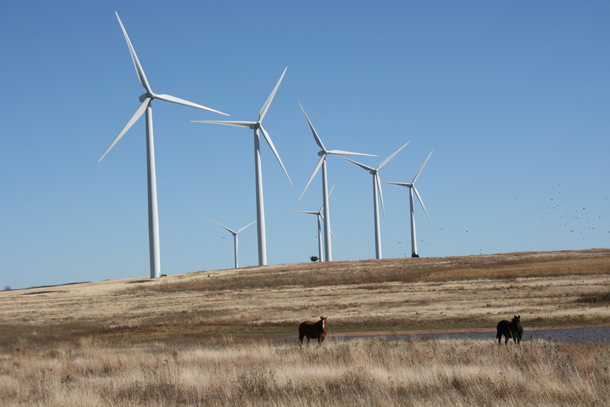
Wind turbines generate power near Weatherford, Oklahoma. Though this state may not be producing many alternative energy-friendly politicians, it has nonetheless become a wind energy powerhouse. (Photo: Travel Aficionado, Flickr CC BY-NC 2.0)
And then there’s the wind and solar industry. Prices are dropping faster than imagined, offshore wind projects are finally underway, rooftop solar is advancing despite organized opposition in several states, and states like Oklahoma and Texas, which have given us Scott Pruitt, and Lamar Smith and Joe Barton among others, are now wind power strongholds.
CURWOOD: All of this adds up to a very interesting year to come.
DYKSTRA: It surely does.
CURWOOD: And I’m sure you’ll keep an eye on it – Peter Dykstra is with Environmental Health News, that’s ehn.org, and dailyclimate.org – Thanks a lot Peter!
DYKSTRA: Thanks, Steve – Talk to you soon!
CURWOOD: And there’s more on all of this at our website, loe.org.
Related links:
- The Atlantic: “Trump and the Paris Agreement: What Just Happened?”
- NYTimes: “It’s Cold Outside. Cue the Trump Global Warming Tweet.”
- Climate Solutions Caucus
- The Atlantic: “The GOP Tax Bill Could Forever Alter Alaska’s Indigenous Tribes”
- Politico: “Donald Trump’s Year of Living Dangerously”
- The Texas Tribune: “Lamar Smith retiring from Congress”
- The Texas Tribune: “U.S. Rep. Joe Barton retiring after graphic photo posted online”
- The Washington Post: “To round out a year of rollbacks, the Trump administration just repealed key regulations on fracking”
- The Washington Post: “Trump administration to overhaul safety-monitoring rules for offshore drilling”
- The Washington Post: “Trump administration eases rule against killing birds”
- Associated Press: “EPA chief jets to Morocco to help promote fossil fuel use”
- CNN: “EPA pulls agents from criminal investigations to guard Pruitt”
- Electric Light & Power: “DOE announces $3.7 billion more in loan guarantees for Plant Vogtle nuclear”
[MUSIC: Jorge Ball Vargas with Inti Illimani, “La Marusa” on Sing To Me the Dream (Un Canto Solidario), composed by Jorge Ball, produced/distributed by Holly Near]
Sounds of Winter
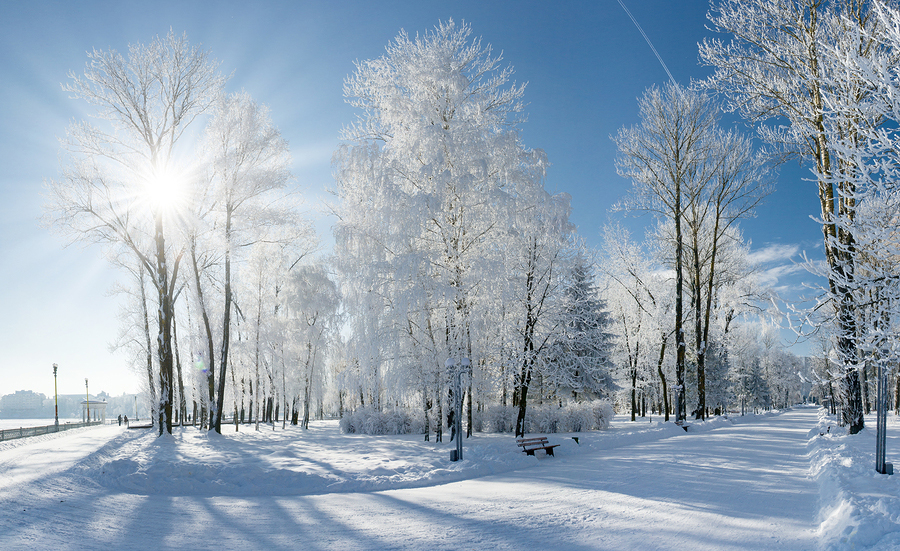
A beautiful winter landscape. (Photo: Bigstockphoto)
CURWOOD: In parts of the country this winter is rather unusual, with record-breaking cold, punctuated by blizzards. Such weather might tempt us to hunker down by the fire with hot chocolate, though it would be a shame to overlook some of the special pleasures of winter that can strike the ear. And here to give us a tour is Living on Earth commentator and New Hampshire resident Sy Montgomery.
[CHICKADEE CHIRPING AND WINGS FLAPPING]
MONTGOMERY: At no other time of the year are sounds so sharp. The scolding winter call of the chickadee. Wind howling through oaks, or whispering through pines. The clarion call of wind chimes, piercing as the cold itself.
[XYLOPHONE-LIKE SCALE OF WIND CHIMES SOUNDING]
MONTGOMERY: Hearing may be the richest sense. Helen Keller wrote she felt its absence a handicap far worse than blindness. As if to make up for winter’s void – of colors muted, touch numbed, and scents sealed – winter’s sounds are the most vibrant.
[WHIZZ OF RUBBER SNOW TUBE SLOWING TO A STOP, CHILDREN LAUGHING]
MONTGOMERY: Sound travels further over frozen ground. Frozen surfaces are rock-hard, so they don't absorb sound – they reflect it. And when the atmosphere above is warmer than the ground, sound bounces back toward the ground. Winter’s freeze is like having a sound reflector in the sky.
[SCRAPING, RHYTHMIC GLIDE OF SKATES ON ICE]
MONTGOMERY: Winter’s bareness amplifies and clarifies its voices. Spring and summer are crowded with ambient noise: the sounds of birds and insects, the rustle of animals in the woods, the whisper of grasses and leaves – not to mention the hubbub of so many people and their machines.
[CREAK OF SWAYING TREE]
MONTGOMERY: In summer, leaves absorb sound, especially the higher frequencies. But now, the trees are bare, summertime’s murmurs are hushed, and snow is covered with hard ice crust. Sound slices through the air—stark, clear, pure.

The frozen land of Ice and snow has a sound all its own. (Photo: Bigstockphoto)
[CRUNCH OF FOOTSTEPS IN SNOW]
MONTGOMERY: So this is the best time of year, I think, to go somewhere secluded – just to listen. Listen for the voice of the wind. The ancients said that Boreas, the north wind, loved a nymph who was changed into a pine tree. Boreas still rages and howls through oaks and maples and beech, but his voice is quite different when he speaks to his love.
Listen to the voices of the trees. They creak like rusty hinges as they sway in the wind. Sometimes trees will even pop loudly – it can sound like fireworks – their wood expanding and contracting during sudden changes in temperature.
Listen to the voice of the ice. On a lake, sometimes, you can hear the ice squeak, or crack, or even boom. Even safe, solid ice will make a cracking sound as it expands. Scary to an ice skater – but if you’re walking in the woods, the booming of a lake is like music.
And remember, in winter, that one of the greatest rewards of listening can be silence. Orchestras know this. At the end of a performance of Mozart’s Fantasy in C Minor, a thousand ears strain for the last note.
[MOZART FANTASIE IN C MINOR RUNNING UNDER]
MONTGOMERY: Silences are different in winter, too. This is not the soft, glowing stillness of pre-spring, or the absorbing quiet of swimming underwater. No, winter’s silence, like its sounds, is piercing, clear and cleansing, like a shooting star, well worth seeking and savoring.
[PIANO MUSIC CONTINUES]
CURWOOD: Sy Montgomery is the author of more than a dozen books including The Good, Good Pig, The Search for the Golden Moon Bear, and The Wild Out of Your Window: Exploring Nature Near At Hand.
[MUSIC FADING AWAY]
Related link:
Sy Montgomery's website
CURWOOD: Next time on Living on Earth -- to fight the dustbowl, FDR called for a wall of trees.
VAUGHAN: They started planting in '35 and they planted for another decade and people saw a real benefit to curbing all this dust; it was one of the few technologies to prevent that.
CURWOOD: But now some farmers are cutting down those protective shelter-belts. That's next time on Living on Earth.
[MUSIC: Mozart, Fantasie #4 in C Minor, K475, pianist Mitsuko Uchida.
https://www.youtube.com/watch?v=Ui9pyxdVX6Y]
CURWOOD: Living on Earth is produced by the World Media Foundation. Our crew includes Naomi Arenberg, Bobby Bascomb, Savannah Christiansen, Jenni Doering, Noble Ingram, Jaime Kaiser, Don Lyman, Helen Palmer, Adelaide Chen, and Jolanda Omari. Tom Tiger engineered our show, with help from Jake Rego. Alison Lirish Dean composed our themes. You can find us anytime at LOE.org - and like us, please, on our Facebook page - it’s PRI’s Living on Earth. And we tweet from @LivingonEarth. I'm Steve Curwood. Thanks for listening!
ANNOUNCER1: Funding for Living on Earth comes from you, our listeners, and from the University of Massachusetts, Boston, in association with its School for the Environment, developing the next generation of environmental leaders. And from the Grantham Foundation for the protection of the environment, supporting strategic communications and collaboration in solving the world’s most pressing environmental problems. Support also comes from the Energy Foundation, serving the public interest by helping to build a strong, clean, energy economy, from Carl and Judy Ferenbach of Boston, Massachusetts and from SolarCity, America’s solar power provider. SolarCity is dedicated to revolutionizing the way energy is delivered by giving customers a renewable alternative to fossil fuels. Information at 888-997-1703. That’s 888-997-1703.
ANNOUNCER 2: This is PRI, Public Radio International.
Living on Earth wants to hear from you!
Living on Earth
62 Calef Highway, Suite 212
Lee, NH 03861
Telephone: 617-287-4121
E-mail: comments@loe.org
Newsletter [Click here]
Donate to Living on Earth!
Living on Earth is an independent media program and relies entirely on contributions from listeners and institutions supporting public service. Please donate now to preserve an independent environmental voice.
NewsletterLiving on Earth offers a weekly delivery of the show's rundown to your mailbox. Sign up for our newsletter today!
 Sailors For The Sea: Be the change you want to sea.
Sailors For The Sea: Be the change you want to sea.
 The Grantham Foundation for the Protection of the Environment: Committed to protecting and improving the health of the global environment.
The Grantham Foundation for the Protection of the Environment: Committed to protecting and improving the health of the global environment.
 Contribute to Living on Earth and receive, as our gift to you, an archival print of one of Mark Seth Lender's extraordinary wildlife photographs. Follow the link to see Mark's current collection of photographs.
Contribute to Living on Earth and receive, as our gift to you, an archival print of one of Mark Seth Lender's extraordinary wildlife photographs. Follow the link to see Mark's current collection of photographs.
 Buy a signed copy of Mark Seth Lender's book Smeagull the Seagull & support Living on Earth
Buy a signed copy of Mark Seth Lender's book Smeagull the Seagull & support Living on Earth

